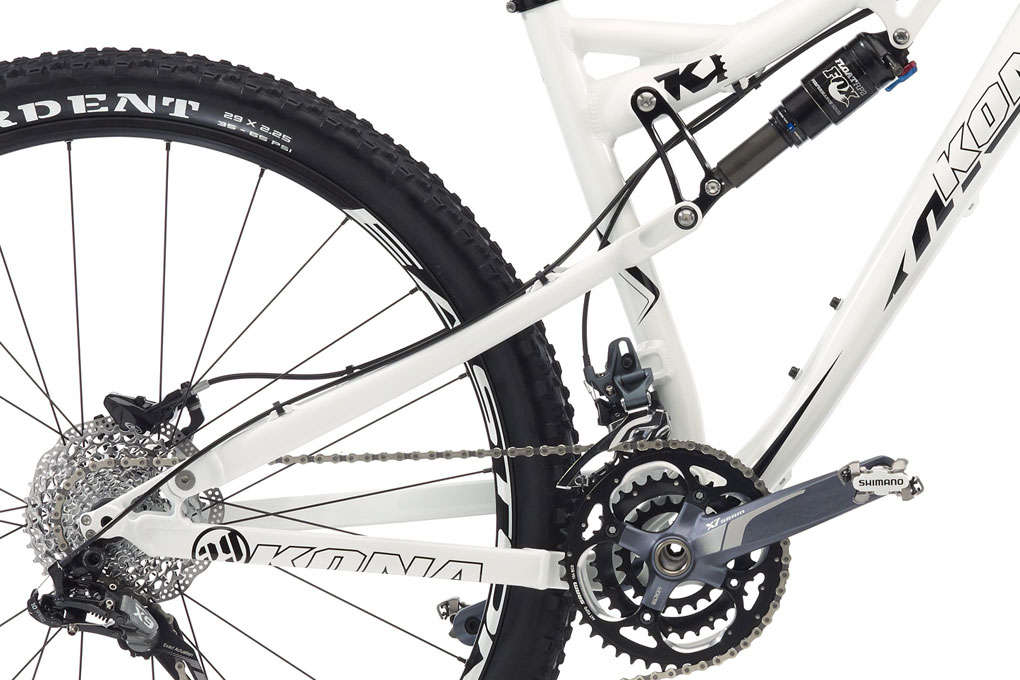Cornering
On the other hand, that unwavering stability becomes a bit of a liability when that high-speed descent dives into a tight corner. It’s an inescapable truth that the bigger 29” wheels don’t turn as quickly as the smaller 26ers do. When you put those big wheels on a really long bike, that trait is amplified. What that means is that the Satori is generally uncooperative when you ask it to go around tight corners at speed.
In a roundabout way, Kona offered a solution to this. The Satori comes equipped with a 20mm thru axle fork and 12mm thru axle rear end, bolted to the portly but reasonably stiff Easton Vice wheels.
The Satori’s rear triangle is also conspicuously overbuilt, which all adds up to a pretty stiff package. What this means is that, as you’re panic-braking down some fast chunder into that tight corner that just popped in to say hello, you can throw the bike sideways, and it’ll take it in stride.
While coming into a corner sideways is a ton of fun, generally this isn’t something I like to do on my normal trail rides because (1) it’s somewhat destructive to the trails, making the IMBA gods frown down upon me; and (2) it’s kinda scary because I’m about 95.7% out of control. It is, however, something that I found myself doing a lot on the Satori.
Maybe this is simply testament to how much ass I was hauling, but more realistically I think it’s just empirical evidence that the Satori is largely unwilling to make significant deviations from a straight line, which means I end up backing it into corners more often than usual. If I’d been able to spend more time on the bike, I feel that I would have become a bit more accustomed to this procedure, potentially reducing my out-of-control ratio to somewhere in the 88% ballpark.
Climbing / Pedaling
But I didn’t get to rip down those hills in a mildly controlled fashion without first riding up them, so how was the Satori on the climbs? Well, it’s pretty heavy, and it doesn’t really pedal that well. While this is somewhat embarrassing to admit, I also found that the easy gear of the 2X10 setup (26T in the front, 36T in the back) could have been a bit easier on those really steep climbs.
With Time pedals, my test Satori weighed right around 31.5 lbs, which is quite a bit for a $3,000 bike with 5” of travel. It’s certainly possible to find a comparable bike for $3,000 that’s a pound or two (or three) lighter. To be fair, not all of those bikes necessarily have the geometry or the stiffness of the Satori, but I’m not sure that accounts for the extra heft of the Satori.
Kona’s faux bar linkage consists of the rear wheel arcing around a single pivot point just behind the bottom bracket, and then a couple other links and pivots to actuate the shock and help stiffen things up. Kona has been using this design in some form or another since the dark ages (1994, to be more specific). The upside to this design is that it’s simple, it’s a known quantity, and it doesn’t violate any patents owned by Specialized.
The downside is that, compared to many of the newer designs out there today, it doesn’t pedal especially well, and its bump-sucking abilities, while fine, aren’t so unbelievably awesome as to outweigh the mediocre pedaling characteristics.

The increasingly refined pedaling platforms built into today’s rear shocks do a pretty good job of masking the suspension’s inherent bobb-y-ness, but that doesn’t get around the fact that if you want the Kona to pedal efficiently, you’re relying on the shock’s compression gadgetry. My Satori was equipped with a Fox Float RP23, and with ProPedal on, the bike pedaled “OK,” but it’s a far cry from (for instance) a DW-link bike.

Where is the other dudes follow up review? I want to read it